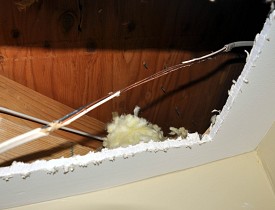Dumb Things People Do That Ruin Drywall
 Back in the old days, builders constructed walls of lath and plaster. The amount of work and skill needed for those installs is mind-blowing compared to the ease of drywall. Drywall, however, is not quite as robust as lath and plaster when a piece of furniture bumps a wall. Dings and gouges are just one type of damage that drywall endures; its greatest enemy is water ... and human error.
Back in the old days, builders constructed walls of lath and plaster. The amount of work and skill needed for those installs is mind-blowing compared to the ease of drywall. Drywall, however, is not quite as robust as lath and plaster when a piece of furniture bumps a wall. Dings and gouges are just one type of damage that drywall endures; its greatest enemy is water ... and human error.
Here is why homeowners have to pay reliable drywall companies to replace their drywall.
Drywall + Water = BAD
I have done a great number of shower remodels where drywall was the backing substrate for tile. Greenboard had a slight advantage over plain drywall with a moisture-resistant “paper,” but these gypsum-based products still share a very moisture-vulnerable core. Today the norm is to use a cement board product in showers for long term durability. A new type of drywall is available with fiberglass facing; this is naturally mold-resistant and makes a great choice for humid locations like baths and laundry rooms.
When drywall gets wet, one of the first results may be mold feeding on the soggy paper “skins.” As the moisture finds its way deeper into the material, the gypsum begins to soften and eventually turn to mush…or crumble away. It doesn't take much water or much time for this to happen.
An example of how destructive water can be: I have done demo on entire shower walls where the damage was so bad that the demolition work was simply done with my bare hands! This moisture issue is not limited to showers. I have seen laundry rooms become mold farms as well as poorly vented baths, flooded garages, kitchen backsplashes, etc.
Holes and Patches
The second most common type of drywall fix I do is “spot” repairs, frequently the dreaded behind-the-door-doorknob-hole. Installing door stops or bumpers to avoid this problem.
Other spot repairs usually have to do with either a plumbing or an electrical problem. Walls are often “opened up” for access to upgrade a faucet or add a new electrical service. They then need to be "closed."
Additional patch repairs are due to leaks. Here not only do you need to fix the source (leaky pipe, valve, drain, etc); you also have to fix all of the damage the leak caused.
Making a patch invisible is pretty tricky -- if not impossible. Textured walls, especially, can be a real tough match; smooth walls are easier in one sense but more difficult when it comes to hiding ridges or seams.
Hanging Wallpaper Directly on Drywall
DIY blogger and Hometalk member Cheri Peoples recalls: "A few years ago we were buying a brand new home. They had beautiful wallpaper up in the house but one room (kitchen) wasn't my style ... I asked if it had been properly prepped. I was told that it had been. We bought the house ... A couple of years later I finally got around to redoing the kitchen. I started working on getting that wallpaper down and OH NO--they had not prepped and not only that but the wallpaper had been applied straight to the dry wall and it was going to rip out chunks. I had luckily begun in an area that could be easily fixed and would not be obvious.
"I ended up painting over the wallpaper in a cappuccino, and rag rolled over it in a mocha cream so you wouldn't notice the lines. I painted over the border in a cranberry and wrote in gold leaf pen. Everyone always commented on how beautiful and I don't think anyone noticed that I had painted over the top of the wallpaper."
Small Holes and Hanger Hardware
Many people hang art and other objects on their walls or attach shelves and other such contrivances. Because drywall is not as sturdy as wood, the mounting screws are set in a “drywall anchor.” Fast forward -- and this shelf or object is no longer needed or wanted. What is left behind is the drywall anchor.
Having worked in many student rentals, I've seen some walls peppered with a dozen or more of these old remnants. Removing them makes an even bigger hole. It is possible to camouflage the anchors somewhat but in many cases you just need to install a bigger piece of art over them.
When layers of drywall problems start to stack up, sometime it is best to hire a contractor to tear out the old and start fresh. Drywall is not overly expensive and a flat, smooth new wall is indeed a thing of beauty.
Kevin Stevens does tile repair and carpentry work in the Denver area.
Updated December 26, 2018.
Looking for a Pro? Call us (866) 441-6648



